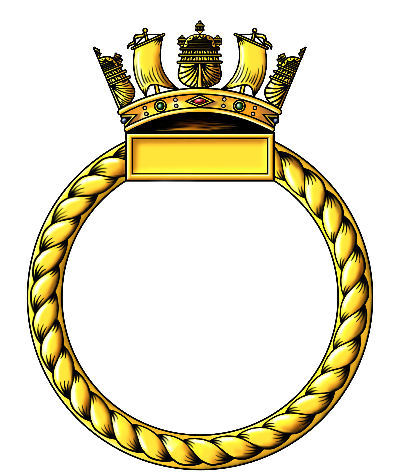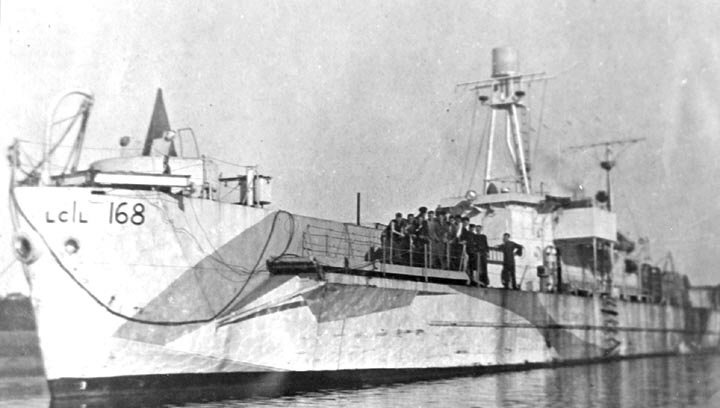Landing Craft Headquarters Ship

No badge issued for this vessel
Battle Honours
Normandy 1944
Specifications
Builder: Federal Shipbuilding & Drydock Co., Newark, New Jersey United States
Displacement:
Light, 216 t.
Landing, 234 t.
Loaded, 389 t.
Length: 156 ft 5.5 in
Beam: 23 ft 3 in
Draught:
Light, 3' ft 1½ in mean
Landing, 2 ft' 8 in forward, 4 ft 10 in aft
Loaded, 5 ft 4 in forward, 5 ft 11 in aft
Propulsion: Two General Motors Quad units (4 General Motors 6051 series 71 Diesel engines per unit), driving twin variable pitch propellers, 2,320shp, 1 Quad unit per shaft.
Speed: 16 Knots
Cargo Capacity:
9 officers and 200 troops or 75 tons cargo - reduced by 50 troops after conversion.
Armament: Four single 20mm Oerlikon guns, mounted in tubs, one bow mounted, one mounted centrally on top of the superstructure aft of wheelhouse, one each port and starboard aft of superstructure.
Crew complement:
(LCI) 3 officers, 17 ratings
(LCH) 3 officers, 23 ratings
Commanding Officers
Lt Wilfred Bostock RNVR
Related items
None
Reminiscences
None
Gallery
None
H.M.S. LCH-167

No image available for LCH 167 - this is her sister ship LCH 168, after conversion but still wearing the pennant LcI(L) 168 C. autumn 1943. Photo: NavSource Online: Amphibious Photo Archive
Early history
Ordered and delivered as a Landing Craft Infantry (Large) for the US Navy she was built by the Federal Shipbuilding & Drydock Co., Newark, New Jersey. She was laid down August 26th 1942 as hull number 320. She was launched on October 22nd 1942 and was transferred to the Royal Navy under the lend-lease agreement at Staten Island, New York, and commissioned on November 12th 1942 as HMLCI(L) 167.
After a short work up and shake-down in the New York area she sailed for Norfolk Navy Yard, Virginia, arriving at pier #3 on November 22nd for repairs and alterations. This entailed the installation of plastic armour and sounding equipment, the fitting of sponsons and flareplates, repairs to hull, electrical system and main engines; she also received a replacement winch and pinace. Before leaving Norfolk she was degaussed and calibrated at the Sewalls Point Magnetic Range, and visited the US Naval Ammunition Depot, St. Juliens Creek, Virginia, to embark small arms and gun ammunition.
On December 12th 1942 she sailed for Bermuda as part of the second flight of completed LCI(L)s, in company with sister ships LSI(L) 98, 100, 164, 165, 166, 168, 239, escorted by the tugs HMRT LARIAT & USS SCIOTA, arriving at Bermuda ten days later. The flight sailed for Gibraltar on the 29th, LCI(L) 7 (a straggler from the first flight) and the Rescue Tug HMRT DESTINY joined the group to make the crossing.
Operation GOVERNOR
It is unclear when the ship reached the UK but she next appears as allocated to participate in Operation GOVERNOR, an attempt to lure the TIRPITZ and other German heavy battleships out of harbour by simulating a raid on southern Norway at the end of July 1943. The operation employed five separate forces. Force A: Battleships HMS ANSON and USS ALABAMA, carrier ILLUSTRIOUS, destroyers MILNE, MUSKETEER, METEOR, and MAHRATTA, USS RODMAN, MACOMB, EMMONS, and FITCH; Force B: Battleships DUKE OF YORK and USS SOUTH DAKOTA, carrier UNICORN, cruiser BERMUDA, destroyers ONSLOW, OBDURATE, OBEDIENT, ULSTER, GRENVILLE, MATCHLESS, SAUMAREZ, SCORPION, and IMPULSIVE; Force C:(representing a convoy), destroyers SAVAGE and RIPLEY, trawlers SKY, SWITHA, CEDAR, LARCH, OAK, WILLOW, HAWTHORNE, and LILAC, MLs 252, 286, 442, 473, and 445, LCI (L) 167; Force D: Cruiser BELFAST , destroyers ORWELL and ORIBI; Force E: Cruisers LONDON, KENT, and NORFOLK. LCI(L) 167 sailed with Force C from Sullom Voe on July 27th to make their run as a dummy convoy, arriving back at Sullom Voe on the 29th, and Scapa Flow on the 30th. The Operation was carried out according to plan and was considered to have been successful. Only one force (Force D) was shadowed for certain but four BV 138 aircraft were shot down during the operations, two by Martlets from ILLUSTRIOUS and two by Beaufighters from RAF 18 Group; no German battleships were tempted out. There is no information about her employment after this operation. .
Conversion to a Headquarters Ship
Early in 1944 she was converted into an LCH, Landing Craft Headquarters by the RN and transferred to the RCN. The conversion involved turning part of the troop decks into operations rooms and wireless offices and the installation of command and control equipment; 6 x Army No. 22 Radio sets; 6 X CDG, B28 receivers; 1 X CDF, B29 receiver. Echo Sounding type 763; 8 type visual signals (lanterns and torches); Type 970 Radar for navigation and control of assault craft; Outfit QH (Gee Hyperbolic Radio Navaid) 1 x TCS Transmitter. A tripod foremast was added to mount the additional aerials. In addition, single cabins were installed to accommodate assault force staff officers when embarked. When completed her troop carrying capacity was reduced by 50.
Operation NEPTUNE
On June 1 1944 she was part of the massing assault forces of Operation NEPTUNE, the seaborne invasion of Normandy. LCH 167 was one of five Landing Craft Headquarters ships in assault force ‘J’, assaulting Juno Beach. Task Force J comprised of troops of the 3rd (Canadian) Division (7th, 8th and 9th Canadian Brigades), plus 48 (RM) Commando, 2nd Canadian Army Brigade. The lowering point for the Landings Ships was seven miles offshore. Juno beach was divided in to three sectors “Love”, “Mike” and “Nan”. “Love” was not an assault sector; this was reserved for off loading equipment and stores. The other two were wide enough to land two brigades side by side. Due to heavy seas, the landing was delayed by ten minutes; the Canadian 7th Brigade landed at Courseulles-sur-Mer, “Mike sector” west of Courseulles-sur-Mer at 07:45 and the 8th Brigade, “Nan Sector” between Courseulles-sur-Mer and Saint-Aubin-sur-mer at 07:55.
LCH 168 carried Cmdr. Jonas DSC RN., Deputy Senior Officer Assault Group J.1, landing on sector “MIKE Red”; LCH 98 D.S.O.A.G. Assault Group J.3 “NAN Green” sector, Commander Struben RN; LCH 239 D.S.O.A.G. Assault Group J.2 “NAN White” sector, commander R.E.D. Ryder VC RN: LCH 167 D.S.O.A.G. Assault Group J.4 “NAN Red” sector, Lt. commander Artuthnot RN; a fifth, unidentified LCH carried the Principle Ferry Craft Control Officer, commander Brunton, responsible for Motor Transport, Stores & personnel. There is no mention of an LCh allocated for “MIKE Green” - from 7th Brigade two assault companies of the Royal Winnipeg Rifles, one assault company of the Canadian Scottish Regiment, and one squadron of the 1st Hussars were to land on "MIKE Red" and also on "MIKE Green", while the Regina Rifle Regiment, supported by a second squadron of the 1st Hussars, landed on "NAN Green" sector with the objective of subduing German forces in Courseulles-sur-Mer. 8th Brigade landed in “NAN White” & “NAN Red” sectors with the objective of subduing German forces in Bernières-sur-mer and Saint-Aubin-sur-mer.
By the end of D-Day 3,200 vehicles and 2,500 tons of materiel have been landed on the Canadian beaches. Losses are 946 killed, wounded and missing out of a total of 15,000 men engaged.
Reallocated to the East Indies Fleet
At the end of 1944 LCH 167 was allocated for service with the East Indies Fleet and sailed for India early in 1945. After the D-Day landings plans were made to relocate large numbers of Major Landing Craft from the UK to the Eastern theatre under the code name ‘APPIAN’. Convoys of craft, referred to as ‘Flights’, sailed for India and Ceylon calling at Gibraltar, Oran, Malta, Port Said, Aden, and Bombay; the first Flight, ‘A’ sailed on November 15th 1944. It is not clear which flight she sailed with or when she arrived in India.
No further information is available about her service in the Far East.
Post War history
LCH 167 was returned to US custody on May 28th 1946 (probably at Manila) and struck from the Naval Register soon after. She was sold by the State Department, on February 13th 1948, fate unknown.
Last modified: 23 February 2023
Primary information sources
Additional sources:
NavSource Online: Amphibious Photo Archive
LCH-101 entry
www.uboat.net index of British and American
LCI(L)
navypedia.org RN AMPHIBIOUS SHIPS AND CRAFT
D-Day : The assault Allied Landing Craft and Ships
LCH specifications
Combined Operations Staff Notebook (1945)
Accessed July 2015
War Diaries: Found on
www.fold3.com
US Naval Ammunition Depot, St. Juliens Creek, Virginia,
U.S. Naval operating Base, Norfolk.
U.S. Naval operating Base, Bermuda.
U.S. Navy Yard, New York.
Admiralty War Diaries - various dates
Comments (2)
My brother was a crew member on this landing craft LCH 167 R. J. Bowhay from Totnes . This ship was also part of the liberation of the channel islands.
This article gives us a new insight on my Father's role in the Navy. He joined up as cook and he eventually became a leading cook before his discharge. We knew he was part of the crew on LCH-167 and was involved in the D- Day Landings. He possibly joined LCH - 167 at Rosneath in Dunbartonshire, Scotland, which we believe was a Landing Craft base. We never had any of these details before, but now have seen a new dimension of his involvement in WW II.
In 2015, he eventually received the 'Insignia of Chevalier de la Legion d’Honneur' from the French Government, in recognition of his involvement in the Liberation of France during the Second World War.
He used to tell us how after the war he went to Malta and India, but never how he got there. It would now seem very possible that it was aboard LCH -167 (see above). The photograph show's my Father in his Naval uniform at the age of between 18-20.